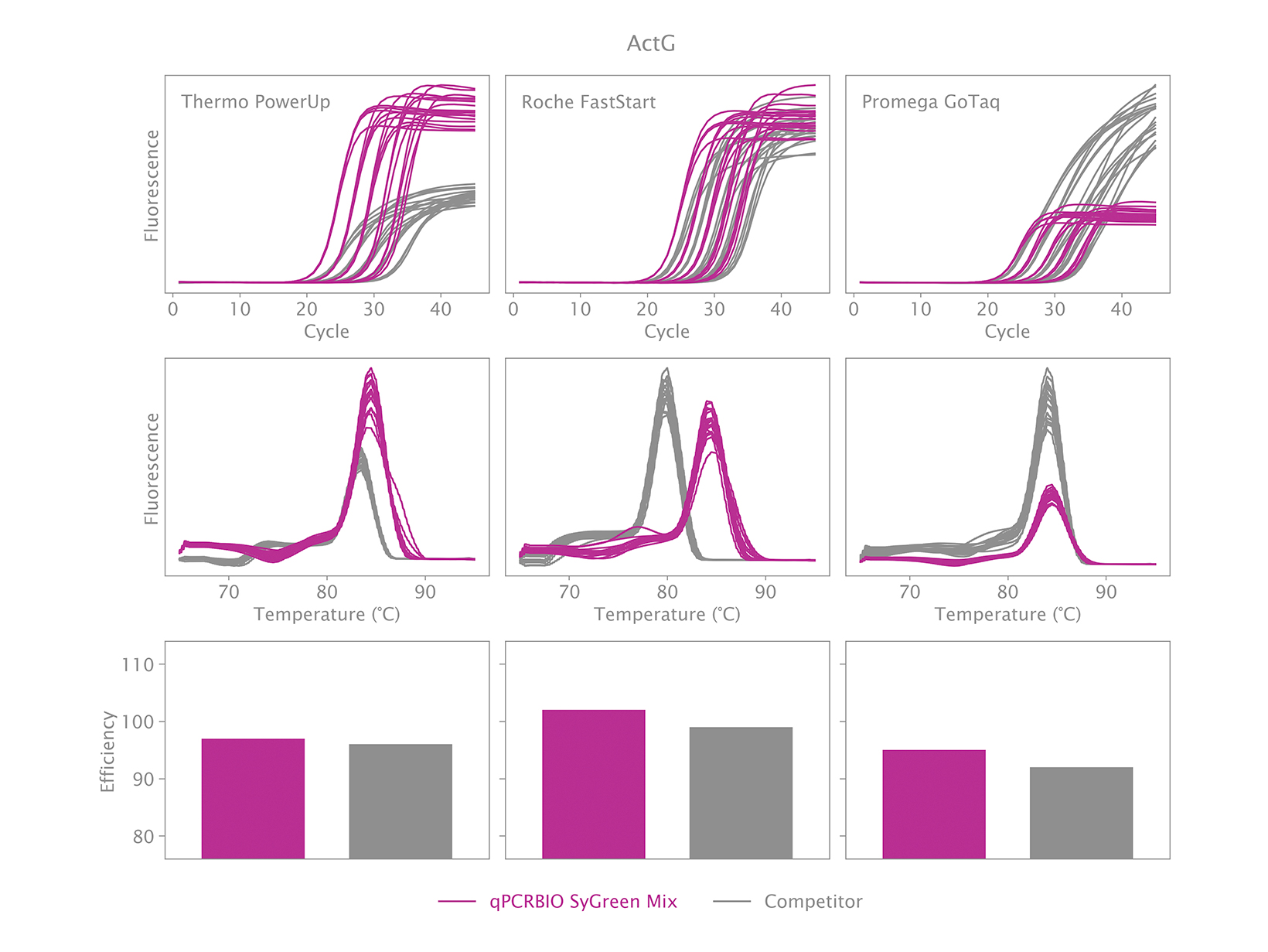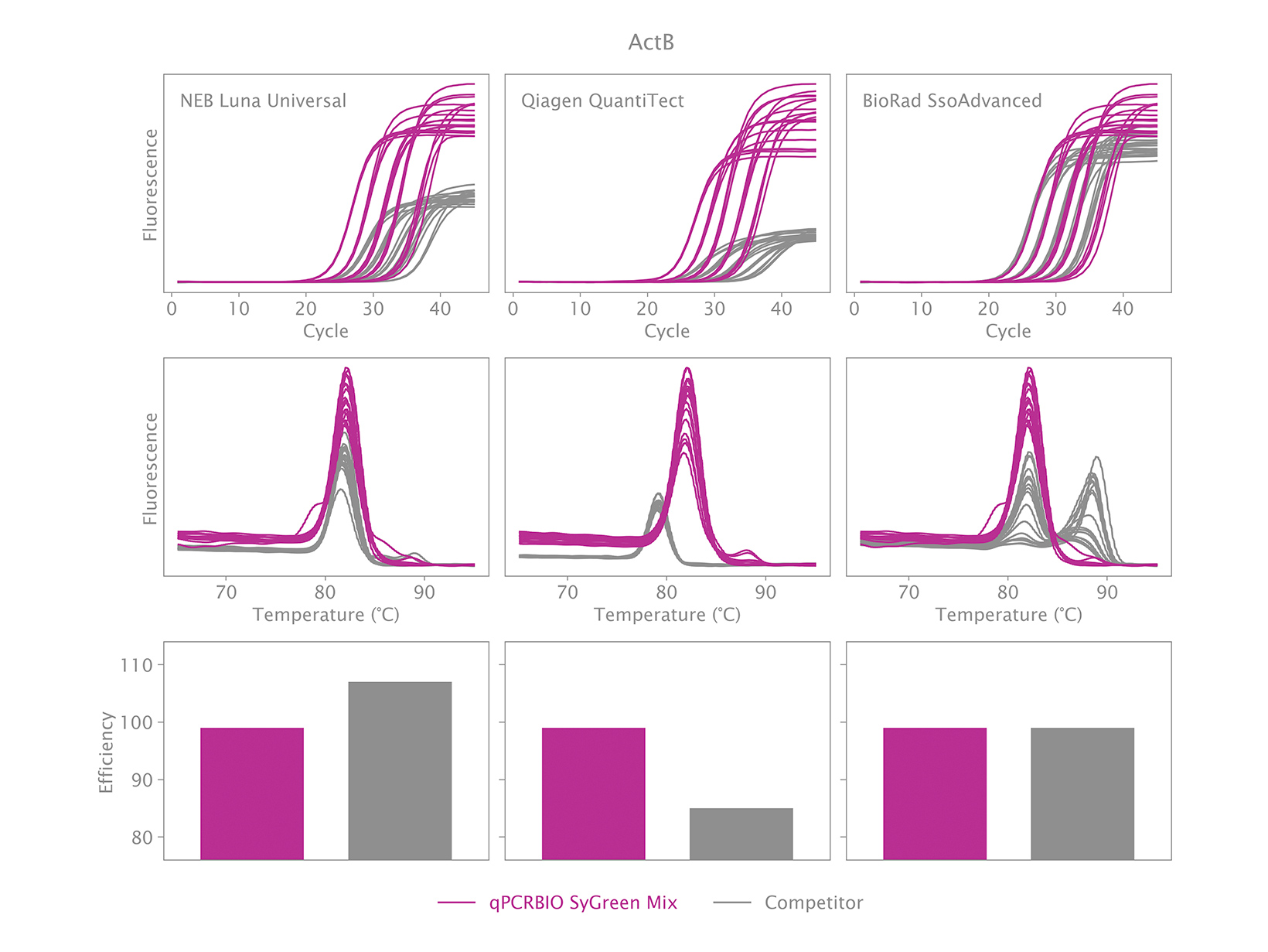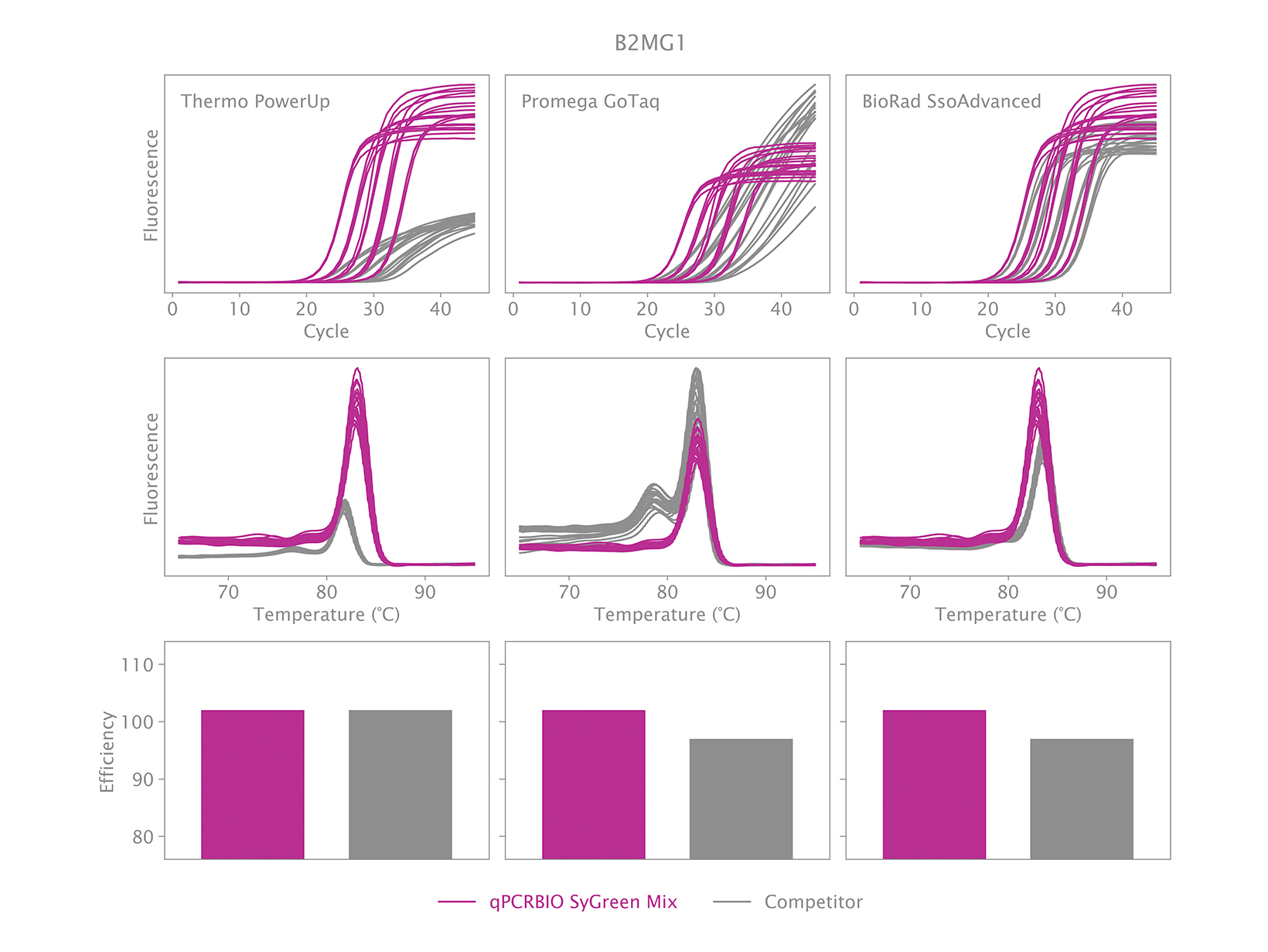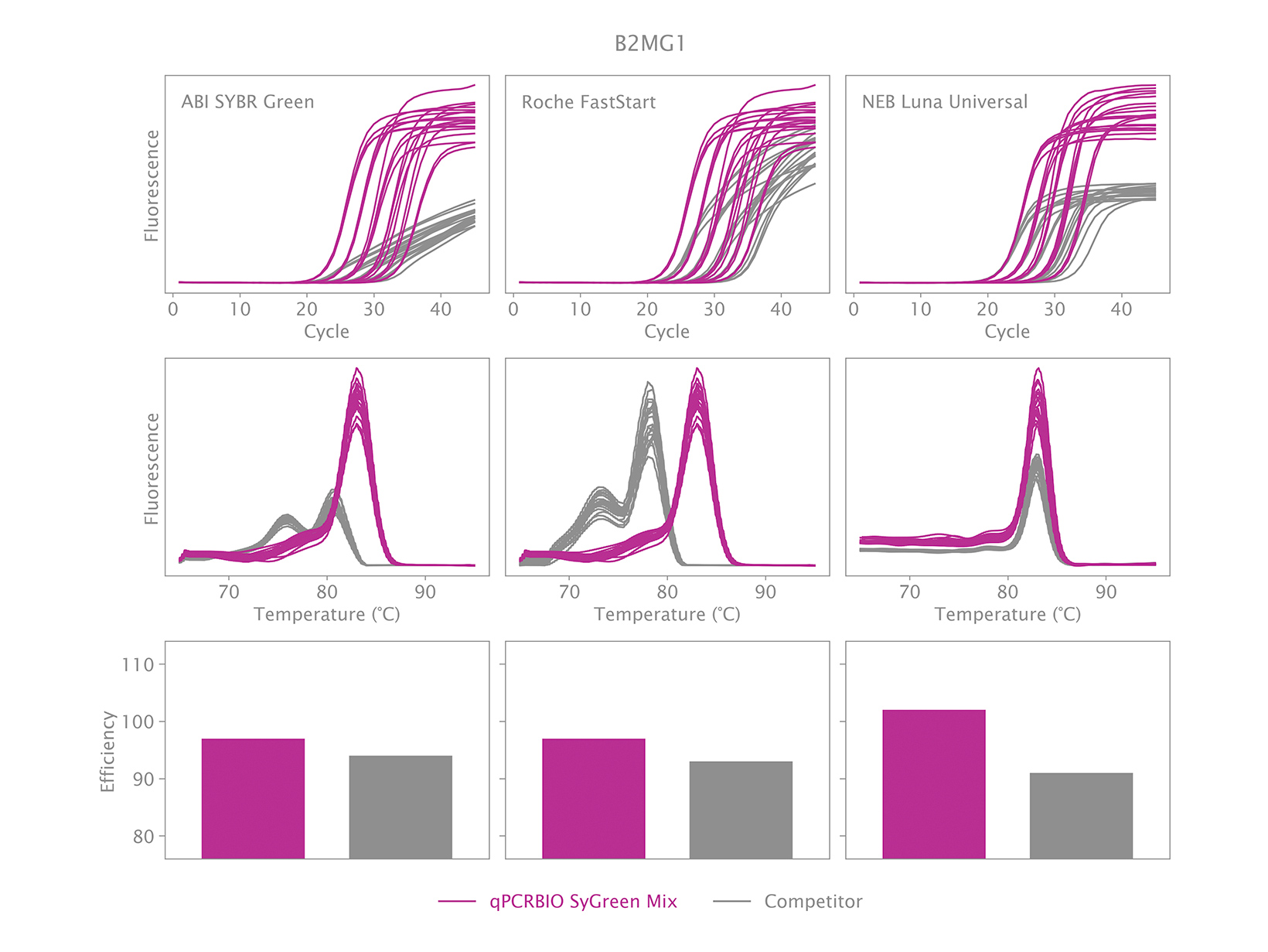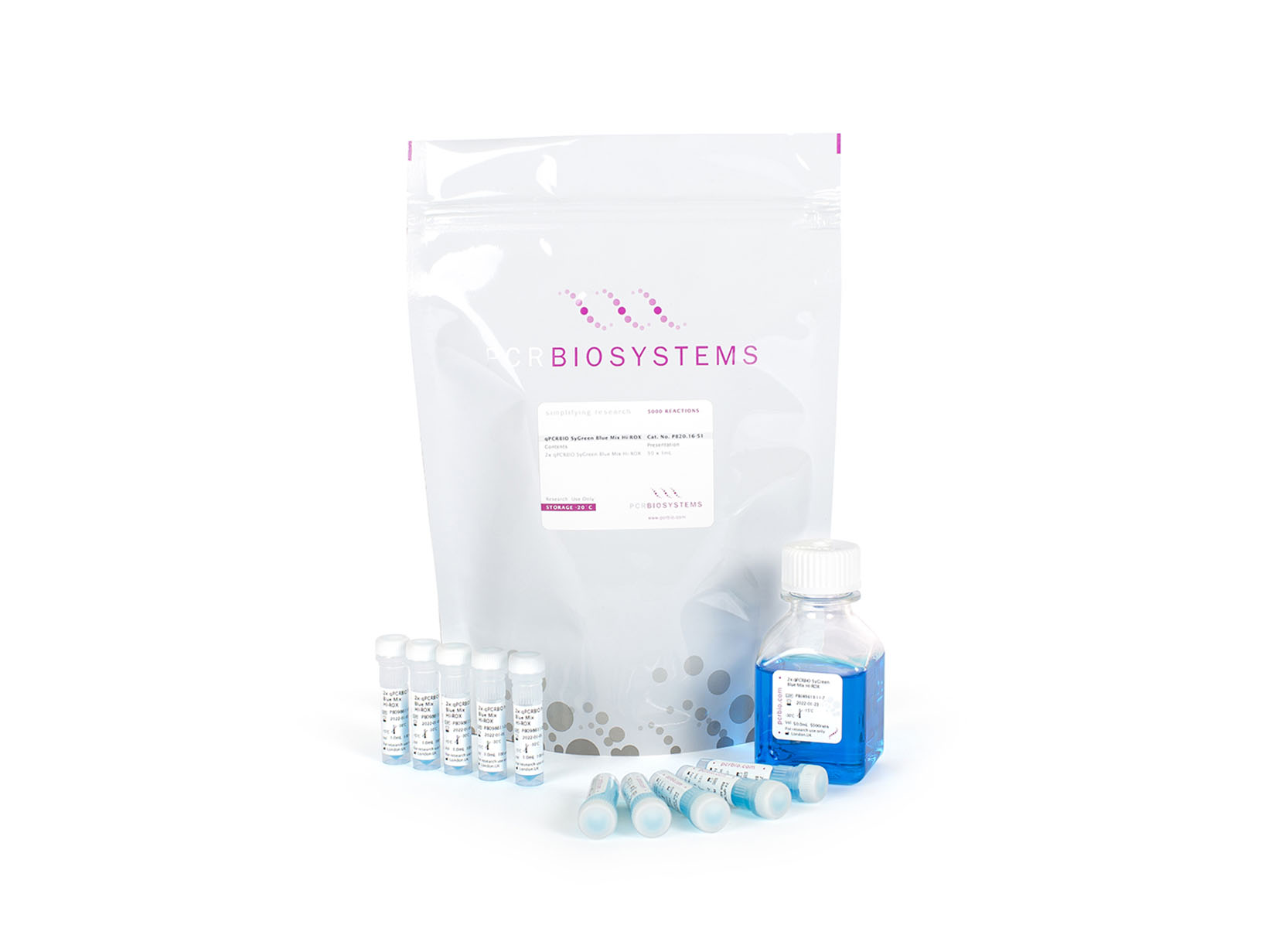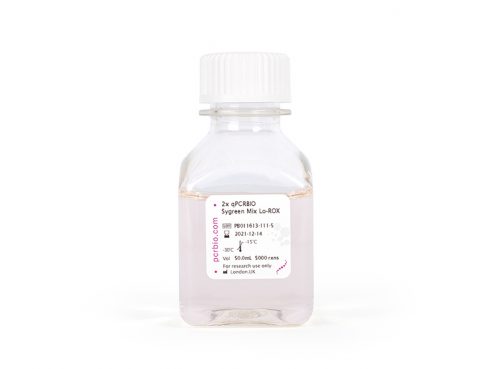To view your price please login or contact us
qPCRBIO SyGreen Blue Mix
This easy-to-see mix uses a non-reactive blue dye for easy sample visualisation during reaction setup, allowing fast, highly sensitive and reproducible real-time PCR with more precision and accuracy than ever.
qPCRBIO SyGreen Blue Mix is particularly useful in reducing errors when loading small volume reactions or using white plates.
Features
- Easy-to-see blue mix for greater pipetting precision and accuracy
- Rapid extension rate for early Ct values
- Market-leading sensitivity – increased limit of detection
- Specific amplification from complex templates including GC-rich sequences
- Non-PCR inhibiting intercalating dye
- Compatible with all standard and fast cycling real-time instruments
More Information
Our blue mixes contain a non-reactive dye to improve reaction mix visibility, allowing greater pipetting precision and reduced errors without affecting your real-time PCR performance. qPCRBIO SyGreen Blue Mix can be used to quantify any DNA template including genomic, cDNA and viral sequences, and is able to reliably detect extremely low copy number targets. The antibody-mediated hot start system prevents the formation of primer dimers and non-specific products leading to greatly improved reaction sensitivity and specificity.
This 2x mix uses a proprietary intercalating dye that does not inhibit PCR, unlike other popular fluorescent dyes. The same developments that improve the sensitivity and consistency of qPCRBIO SyGreen Blue Mix in standard cycling conditions also allow for industry-leading performance in fast and ultra fast cycling conditions.
Use our qPCR Selection Tool to find out which ROX variant is compatible with your instrument.
Applications
- Absolute quantification
- Relative gene expression analysis
- High-throughput qPCR from genomic, cDNA and viral sequences
- Detection of extremely low copy number targets
- Crude sample PCR
Specifications
qPCRBIO SyGreen Blue Mix Lo-ROX
Component
100 Reactions
500 Reactions
2000 Reactions
5000 Reactions
5000 Reactions
2x qPCRBIO SyGreen Blue Mix Lo-ROX
1 x 1mL
5 x 1mL
20 x 1mL
1 x 50mL Bottle
50 x 1mL in Pouch
qPCRBIO SyGreen Blue Mix Hi-ROX
Component
100 Reactions
500 Reactions
2000 Reactions
5000 Reactions
5000 Reactions
2x qPCRBIO SyGreen Blue Mix Hi-ROX
1 x 1mL
5 x 1mL
20 x 1mL
1 x 50mL Bottle
50 x 1mL in Pouch
qPCRBIO SyGreen Blue Mix Separate-ROX
Component
100 Reactions
500 Reactions
2000 Reactions
5000 Reactions
5000 Reactions
qPCRBIO SyGreen Blue Mix No-ROX
1 x 1mL
5 x 1mL
20 x 1mL
1 x 50mL Bottle
50 x 1mL in Pouch
50μM ROX Additive
1 x 200μL
1 x 200μL
4 x 200μL
2 x 520μL
2 x 520μL
qPCRBIO SyGreen Blue Mix Lo-ROX
Component
2x qPCRBIO SyGreen Blue Mix Lo-ROX
100 Reactions
1 x 1mL
500 Reactions
5 x 1mL
2000 Reactions
20 x 1mL
5000 Reactions
1 x 50mL Bottle
5000 Reactions
50 x 1mL in Pouch
qPCRBIO SyGreen Blue Mix Hi-ROX
Component
2x qPCRBIO SyGreen Blue Mix Hi-ROX
100 Reactions
1 x 1mL
500 Reactions
5 x 1mL
2000 Reactions
20 x 1mL
5000 Reactions
1 x 50mL Bottle
5000 Reactions
50 x 1mL in Pouch
qPCRBIO SyGreen Blue Mix Separate-ROX
Component
qPCRBIO SyGreen Blue Mix No-ROX
50μM ROX Additive
100 Reactions
1 x 1mL
1 x 200μL
500 Reactions
5 x 1mL
1 x 200μL
2000 Reactions
20 x 1mL
4 x 200μL
5000 Reactions
1 x 50mL Bottle
2 x 520μL
5000 Reactions
50 x 1mL in Pouch
2 x 520μL
Reaction Volume
Storage
20μL
On arrival, products should be stored between -30 and -15°C. If stored correctly the kit will retain full activity for 12 months.
Reaction Volume
20μL
Storage
On arrival, products should be stored between -30 and -15°C. If stored correctly the kit will retain full activity for 12 months.
Instrument Compatibility
This product is compatible with all standard and fast cycling qPCR instruments. Use our qPCR Selection Tool to find out which ROX variant is compatible with your instrument.
Documents
Product Flyers
Product Manuals
Material Safety Data Sheets
Certificate of Analysis Finder
FAQs
Can products generated with qPCRBIO SyGreen Blue Mixes be digested, cloned, and sequenced?
Yes, PCR products generated with qPCRBIO SyGreen Blue Mixes have the same characteristics as PCR products generated with wild-type Taq polymerase. They may be sequenced or digested with restriction endonucleases using standard protocols. Products are 3′-d(A)-tailed and may be used for TA cloning or may be blunt-ended or digested with restriction enzymes prior to cloning. For best results, we recommend purifying the PCR products using any standard PCR clean-up kit.
Can ROX have a negative impact on the reaction?
ROX (6-carboxy-X-rhodamine) is used as a passive reference dye in ROX-dependent real-time PCR instruments to normalize for variations of fluorescence levels that can arise mainly due to optical path variations among wells. Normalisation of the fluorescence intensity (Rn) is done in real-time PCR software by dividing the emission intensity of the specific signal by the emission intensity of ROX.
ROX does not take part in the PCR reaction and its fluorescence levels are not proportional to the quantity of DNA in each well, so the addition of this fluorophore to a mix provides a constant fluorescent signal during amplification.
Different types of real-time PCR instruments requiring a passive reference standard have different optimal concentrations of ROX, mainly due to the different optical configurations of each system (i.e. the different type of excitation source and optics used).
The addition of either too little or too much ROX would result in a very noisy signal impacting on the results of the reaction. Therefore, it is extremely important for the user to:
- Determine the correct ROX concentration to optimise real-time PCR results, and
- Check the ROX settings on the software used to set up the reaction
A useful selection tool for the most commonly used systems can be found here.
Do qPCRBIO SyGreen Blue Mixes work with bisulphate converted gDNA template?
Yes. We have customers who have reported successful use of qPCRBIO SyGreen Mix on bisulphate converted gDNA.
Is the storage of sample DNA in 1x TE (10 mM Tris-HCl / 1 mM EDTA) buffer compatible with subsequent qPCR using qPCRBIO SyGreen Blue mixes?
Yes, this storage buffer is compatible. The EDTA will chelate some of the magnesium in the mix, but not significantly enough to affect the reaction.
qPCRBIO SyGreen Blue Mixes contain the dye SyGreen. Does it belong to the SYBR green family?
SyGreen belongs to the family of asymmetric cyanine dyes, which is the same family that SYBR™ Green belongs to. SyGreen is an improved, new generation dye from this family. Similar to SYBR™ Green, SyGreen intercalates the DNA. Unlike SYBR™ Green, SyGreen supports PCR amplification over a wide range of dye concentrations, that is, the dye does not inhibit the PCR reaction. This plays a role in producing robust and consistent DNA melting curves both with prokaryote and eukaryote templates, as it shows no preference in nucleotide composition.
What are the ROX concentrations in qPCRBIO SyGreen Blue Mixes?
The qPCRBIO SyGreen Blue Mixes that contain passive reference dyes come in different formulations, each with a different concentration of the passive reference dye:
- qPCRBIO SyGreen Blue Mix Lo-ROX (PB20.15) contains 112 nM ROX.
- qPCRBIO SyGreen Blue Mix Hi-ROX (PB20.16) contains 1.12 µM ROX.
- qPCRBIO SyGreen Blue Mix Separate-ROX (PB20.17) 2x mix contains no ROX and include a separate tube of 50 µM ROX additive. This enables you to choose what concentration of ROX you’d like to use.
You can use our qPCR Selection Tool under the Resources drop-down menu to determine which of our mixes are best suited for your qPCR machine.
What is included in qPCRBIO SyGreen Blue Mixes?
qPCRBIO SyGreen Blue Mixes are ready to use qPCR 2x Mastermixes, which also contain a blue dye. You only need to add primers, template DNA and PCR grade water during reaction set up.
What is ROX?
ROX is a passive reference dye which means it does not take part in the PCR reaction. It is used to normalise non-PCR related fluctuations in fluorescence.
What is the blue dye for?
qPCRBIO SyGreen Blue Mixes (PB20.15, PB20.16, and PB20.17) contain a non-reactive blue dye has been added for convenience to assist researchers during pipetting. It does not affect the efficiency of the PCR reaction. Although the blue dye can slightly reduce the fluorescence signal, it does not affect the Ct values obtained.
What is the error rate of the HS Taq DNA Polymerase used in qPCRBIO SyGreen Blue Mixes?
The enzyme has an error rate of approximately 1 error per 2.0 x 10⁵ nucleotides incorporated.
What is the MgCl2 concentration in qPCRBIO SyGreen Blue Mixes?
All qPCRBIO SyGreen Blue Mixes contain MgCl2 at a concentration of 6 mM. This means the final concentration in the reaction is 3 mM.
What should be considered if the normalisation of signal with ROX appears to be lower relative to a competitor’s mix?
Ensure you are using the right concentration of ROX because different instruments require different ROX concentrations. For example, if a qPCRBIO SyGreen Blue Mix Hi-ROX is used with an instrument requiring a Lo-ROX mix, the software will normalise the qPCRBIO signal against the Hi-ROX level. This will significantly reduce the fluorescence level of the qPCRBIO mix relative to competitors’ mixes, if in that case the Lo-ROX mix was chosen for the competitor.
When comparing mixes from different manufacturers, it is better to carry out separate runs or turn the passive reference off before analysing data.
What troubleshooting is recommended if efficiency of amplification is reduced with standard dilutions?
It has been reported that efficiency can decrease with subsequent dilutions for the standard curve. We recommend avoiding this by diluting the standards in 10 mM Tris-HCl pH 8.0, 0.1 mM EDTA, 0.05% Tween-20. EDTA is a chelating agent and it plays a role in preventing DNAse activity1. Tween-20 is a detergent and prevents the DNA from adsorbing to the sides of the tubes2. Most microcentrifuges are made of polypropylene and research has demonstrated that DNA sticks very well to polypropylene3.
Standards should not be frozen after diluting them. Even in the presence of detergent, freezing seems to cause DNA to bind irreversibly to polypropylene. We suggest leaving your standards at 4°C and preparing a fresh batch every few weeks.
1 Barra, G. B. et al. EDTA-mediated inhibition of DNases protects circulating cell-free DNA from ex vivo degradation in blood samples. Clin Biochem 48, 976-981, doi:10.1016/j.clinbiochem.2015.02.014 (2015).
2 Linnarsson, S. Recent advances in DNA sequencing methods – general principles of sample preparation. Exp Cell Res 316, 1339-1343, doi:10.1016/j.yexcr.2010.02.036 (2010).
3 Gaillard, C. & Strauss, F. Avoiding adsorption of DNA to polypropylene tubes and denaturation of short DNA fragments. Technical Tips Online 3, 3 (1998).
What troubleshooting is recommended if the background signal is very high?
A high background level of fluorescence is most likely due to an excess of template in the reaction. This relates to the qPCR instrument picking up the SyGreen dye which binds to the template DNA. Samples usually contain a lot of DNA other than the target gene, so there will be enough present to register fluorescence. We recommend diluting the samples 100x-1000x to overcome this issue.
This should not only reduce the background signal, but also allow an accurate quantification because the dilution should bring the Ct values in the range of those obtained with the standards. Keep in mind that if the Ct is earlier than the first standard, it won’t be considered accurate enough quantification for publication.
Why is there a non-specific product when using the same primers and PCR conditions as a competitor’s product?
It’s most likely because the time for the 1st step (hot start) is too short. Ensure that the hot start phase is done at 95°C for 2 minutes to fully activate the enzyme. The recommended thermal profile is:
- 95°C (120 seconds)
- 40 cycles: 95°C (5-15 seconds) – 60°C (20-30 seconds)
- Melt
If non-specific products are still obtained, we recommend raising the annealing/extension temperature from 60°C to 65°C, depending on the primer set used.
Why is there an earlier Ct when using qPCRBIO SyGreen Blue Mixes compared to a competitor’s product?
An early Ct could indicate one of two things. The first could be the result of our product performing very well relative to the competitor’s product. We have designed our products to be faster than our competitors, and we have found that we are significantly faster than many.
The second could be that caused by non-specific products. This can be verified by running a melt analysis at the end of the qPCR run. If your results show one peak, it is likely the correct product was amplified. You may observe the position of the peak being different with our mix relative to our competitor’s mix but is this normal because the salt concentration and pH affect the melting temperature. If your results show more than one peak, then the reaction is not specific. PCR products can also be run on an agarose gel to verify if there is only one band, and if it is the same size as the amplicon obtained with the competitor’s product.
To address the issue of a non-specific product, the thermal cycling will need to be adjusted.
More Information
Our blue mixes contain a non-reactive dye to improve reaction mix visibility, allowing greater pipetting precision and reduced errors without affecting your real-time PCR performance. qPCRBIO SyGreen Blue Mix can be used to quantify any DNA template including genomic, cDNA and viral sequences, and is able to reliably detect extremely low copy number targets. The antibody-mediated hot start system prevents the formation of primer dimers and non-specific products leading to greatly improved reaction sensitivity and specificity.
This 2x mix uses a proprietary intercalating dye that does not inhibit PCR, unlike other popular fluorescent dyes. The same developments that improve the sensitivity and consistency of qPCRBIO SyGreen Blue Mix in standard cycling conditions also allow for industry-leading performance in fast and ultra fast cycling conditions.
Use our qPCR Selection Tool to find out which ROX variant is compatible with your instrument.
Applications
- Absolute quantification
- Relative gene expression analysis
- High-throughput qPCR from genomic, cDNA and viral sequences
- Detection of extremely low copy number targets
- Crude sample PCR
Specifications
qPCRBIO SyGreen Blue Mix Lo-ROX
Component
100 Reactions
500 Reactions
2000 Reactions
5000 Reactions
5000 Reactions
2x qPCRBIO SyGreen Blue Mix Lo-ROX
1 x 1mL
5 x 1mL
20 x 1mL
1 x 50mL Bottle
50 x 1mL in Pouch
qPCRBIO SyGreen Blue Mix Hi-ROX
Component
100 Reactions
500 Reactions
2000 Reactions
5000 Reactions
5000 Reactions
2x qPCRBIO SyGreen Blue Mix Hi-ROX
1 x 1mL
5 x 1mL
20 x 1mL
1 x 50mL Bottle
50 x 1mL in Pouch
qPCRBIO SyGreen Blue Mix Separate-ROX
Component
100 Reactions
500 Reactions
2000 Reactions
5000 Reactions
5000 Reactions
qPCRBIO SyGreen Blue Mix No-ROX
1 x 1mL
5 x 1mL
20 x 1mL
1 x 50mL Bottle
50 x 1mL in Pouch
50μM ROX Additive
1 x 200μL
1 x 200μL
4 x 200μL
2 x 520μL
2 x 520μL
qPCRBIO SyGreen Blue Mix Lo-ROX
Component
2x qPCRBIO SyGreen Blue Mix Lo-ROX
100 Reactions
1 x 1mL
500 Reactions
5 x 1mL
2000 Reactions
20 x 1mL
5000 Reactions
1 x 50mL Bottle
5000 Reactions
50 x 1mL in Pouch
qPCRBIO SyGreen Blue Mix Hi-ROX
Component
2x qPCRBIO SyGreen Blue Mix Hi-ROX
100 Reactions
1 x 1mL
500 Reactions
5 x 1mL
2000 Reactions
20 x 1mL
5000 Reactions
1 x 50mL Bottle
5000 Reactions
50 x 1mL in Pouch
qPCRBIO SyGreen Blue Mix Separate-ROX
Component
qPCRBIO SyGreen Blue Mix No-ROX
50μM ROX Additive
100 Reactions
1 x 1mL
1 x 200μL
500 Reactions
5 x 1mL
1 x 200μL
2000 Reactions
20 x 1mL
4 x 200μL
5000 Reactions
1 x 50mL Bottle
2 x 520μL
5000 Reactions
50 x 1mL in Pouch
2 x 520μL
Reaction Volume
Storage
20μL
On arrival, products should be stored between -30 and -15°C. If stored correctly the kit will retain full activity for 12 months.
Reaction Volume
20μL
Storage
On arrival, products should be stored between -30 and -15°C. If stored correctly the kit will retain full activity for 12 months.
Instrument Compatibility
This product is compatible with all standard and fast cycling qPCR instruments. Use our qPCR Selection Tool to find out which ROX variant is compatible with your instrument.
Documents
Product Flyers
Product Manuals
Material Safety Data Sheets
Certificate of Analysis Finder
FAQs
Can products generated with qPCRBIO SyGreen Blue Mixes be digested, cloned, and sequenced?
Yes, PCR products generated with qPCRBIO SyGreen Blue Mixes have the same characteristics as PCR products generated with wild-type Taq polymerase. They may be sequenced or digested with restriction endonucleases using standard protocols. Products are 3′-d(A)-tailed and may be used for TA cloning or may be blunt-ended or digested with restriction enzymes prior to cloning. For best results, we recommend purifying the PCR products using any standard PCR clean-up kit.
Can ROX have a negative impact on the reaction?
ROX (6-carboxy-X-rhodamine) is used as a passive reference dye in ROX-dependent real-time PCR instruments to normalize for variations of fluorescence levels that can arise mainly due to optical path variations among wells. Normalisation of the fluorescence intensity (Rn) is done in real-time PCR software by dividing the emission intensity of the specific signal by the emission intensity of ROX.
ROX does not take part in the PCR reaction and its fluorescence levels are not proportional to the quantity of DNA in each well, so the addition of this fluorophore to a mix provides a constant fluorescent signal during amplification.
Different types of real-time PCR instruments requiring a passive reference standard have different optimal concentrations of ROX, mainly due to the different optical configurations of each system (i.e. the different type of excitation source and optics used).
The addition of either too little or too much ROX would result in a very noisy signal impacting on the results of the reaction. Therefore, it is extremely important for the user to:
- Determine the correct ROX concentration to optimise real-time PCR results, and
- Check the ROX settings on the software used to set up the reaction
A useful selection tool for the most commonly used systems can be found here.
Do qPCRBIO SyGreen Blue Mixes work with bisulphate converted gDNA template?
Yes. We have customers who have reported successful use of qPCRBIO SyGreen Mix on bisulphate converted gDNA.
Is the storage of sample DNA in 1x TE (10 mM Tris-HCl / 1 mM EDTA) buffer compatible with subsequent qPCR using qPCRBIO SyGreen Blue mixes?
Yes, this storage buffer is compatible. The EDTA will chelate some of the magnesium in the mix, but not significantly enough to affect the reaction.
qPCRBIO SyGreen Blue Mixes contain the dye SyGreen. Does it belong to the SYBR green family?
SyGreen belongs to the family of asymmetric cyanine dyes, which is the same family that SYBR™ Green belongs to. SyGreen is an improved, new generation dye from this family. Similar to SYBR™ Green, SyGreen intercalates the DNA. Unlike SYBR™ Green, SyGreen supports PCR amplification over a wide range of dye concentrations, that is, the dye does not inhibit the PCR reaction. This plays a role in producing robust and consistent DNA melting curves both with prokaryote and eukaryote templates, as it shows no preference in nucleotide composition.
What are the ROX concentrations in qPCRBIO SyGreen Blue Mixes?
The qPCRBIO SyGreen Blue Mixes that contain passive reference dyes come in different formulations, each with a different concentration of the passive reference dye:
- qPCRBIO SyGreen Blue Mix Lo-ROX (PB20.15) contains 112 nM ROX.
- qPCRBIO SyGreen Blue Mix Hi-ROX (PB20.16) contains 1.12 µM ROX.
- qPCRBIO SyGreen Blue Mix Separate-ROX (PB20.17) 2x mix contains no ROX and include a separate tube of 50 µM ROX additive. This enables you to choose what concentration of ROX you’d like to use.
You can use our qPCR Selection Tool under the Resources drop-down menu to determine which of our mixes are best suited for your qPCR machine.
What is included in qPCRBIO SyGreen Blue Mixes?
qPCRBIO SyGreen Blue Mixes are ready to use qPCR 2x Mastermixes, which also contain a blue dye. You only need to add primers, template DNA and PCR grade water during reaction set up.
What is ROX?
ROX is a passive reference dye which means it does not take part in the PCR reaction. It is used to normalise non-PCR related fluctuations in fluorescence.
What is the blue dye for?
qPCRBIO SyGreen Blue Mixes (PB20.15, PB20.16, and PB20.17) contain a non-reactive blue dye has been added for convenience to assist researchers during pipetting. It does not affect the efficiency of the PCR reaction. Although the blue dye can slightly reduce the fluorescence signal, it does not affect the Ct values obtained.
What is the error rate of the HS Taq DNA Polymerase used in qPCRBIO SyGreen Blue Mixes?
The enzyme has an error rate of approximately 1 error per 2.0 x 10⁵ nucleotides incorporated.
What is the MgCl2 concentration in qPCRBIO SyGreen Blue Mixes?
All qPCRBIO SyGreen Blue Mixes contain MgCl2 at a concentration of 6 mM. This means the final concentration in the reaction is 3 mM.
What should be considered if the normalisation of signal with ROX appears to be lower relative to a competitor’s mix?
Ensure you are using the right concentration of ROX because different instruments require different ROX concentrations. For example, if a qPCRBIO SyGreen Blue Mix Hi-ROX is used with an instrument requiring a Lo-ROX mix, the software will normalise the qPCRBIO signal against the Hi-ROX level. This will significantly reduce the fluorescence level of the qPCRBIO mix relative to competitors’ mixes, if in that case the Lo-ROX mix was chosen for the competitor.
When comparing mixes from different manufacturers, it is better to carry out separate runs or turn the passive reference off before analysing data.
What troubleshooting is recommended if efficiency of amplification is reduced with standard dilutions?
It has been reported that efficiency can decrease with subsequent dilutions for the standard curve. We recommend avoiding this by diluting the standards in 10 mM Tris-HCl pH 8.0, 0.1 mM EDTA, 0.05% Tween-20. EDTA is a chelating agent and it plays a role in preventing DNAse activity1. Tween-20 is a detergent and prevents the DNA from adsorbing to the sides of the tubes2. Most microcentrifuges are made of polypropylene and research has demonstrated that DNA sticks very well to polypropylene3.
Standards should not be frozen after diluting them. Even in the presence of detergent, freezing seems to cause DNA to bind irreversibly to polypropylene. We suggest leaving your standards at 4°C and preparing a fresh batch every few weeks.
1 Barra, G. B. et al. EDTA-mediated inhibition of DNases protects circulating cell-free DNA from ex vivo degradation in blood samples. Clin Biochem 48, 976-981, doi:10.1016/j.clinbiochem.2015.02.014 (2015).
2 Linnarsson, S. Recent advances in DNA sequencing methods – general principles of sample preparation. Exp Cell Res 316, 1339-1343, doi:10.1016/j.yexcr.2010.02.036 (2010).
3 Gaillard, C. & Strauss, F. Avoiding adsorption of DNA to polypropylene tubes and denaturation of short DNA fragments. Technical Tips Online 3, 3 (1998).
What troubleshooting is recommended if the background signal is very high?
A high background level of fluorescence is most likely due to an excess of template in the reaction. This relates to the qPCR instrument picking up the SyGreen dye which binds to the template DNA. Samples usually contain a lot of DNA other than the target gene, so there will be enough present to register fluorescence. We recommend diluting the samples 100x-1000x to overcome this issue.
This should not only reduce the background signal, but also allow an accurate quantification because the dilution should bring the Ct values in the range of those obtained with the standards. Keep in mind that if the Ct is earlier than the first standard, it won’t be considered accurate enough quantification for publication.
Why is there a non-specific product when using the same primers and PCR conditions as a competitor’s product?
It’s most likely because the time for the 1st step (hot start) is too short. Ensure that the hot start phase is done at 95°C for 2 minutes to fully activate the enzyme. The recommended thermal profile is:
- 95°C (120 seconds)
- 40 cycles: 95°C (5-15 seconds) – 60°C (20-30 seconds)
- Melt
If non-specific products are still obtained, we recommend raising the annealing/extension temperature from 60°C to 65°C, depending on the primer set used.
Why is there an earlier Ct when using qPCRBIO SyGreen Blue Mixes compared to a competitor’s product?
An early Ct could indicate one of two things. The first could be the result of our product performing very well relative to the competitor’s product. We have designed our products to be faster than our competitors, and we have found that we are significantly faster than many.
The second could be that caused by non-specific products. This can be verified by running a melt analysis at the end of the qPCR run. If your results show one peak, it is likely the correct product was amplified. You may observe the position of the peak being different with our mix relative to our competitor’s mix but is this normal because the salt concentration and pH affect the melting temperature. If your results show more than one peak, then the reaction is not specific. PCR products can also be run on an agarose gel to verify if there is only one band, and if it is the same size as the amplicon obtained with the competitor’s product.
To address the issue of a non-specific product, the thermal cycling will need to be adjusted.





